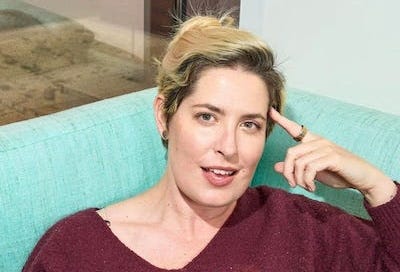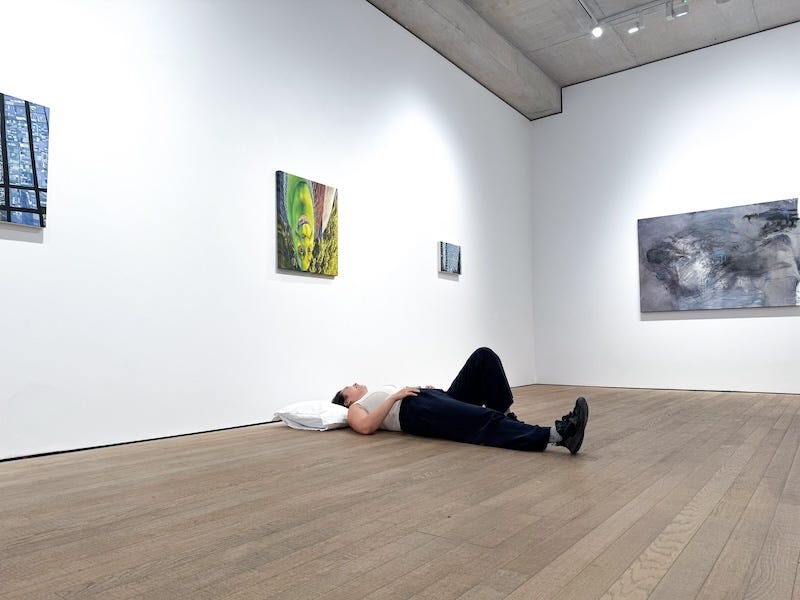“You can be very wild and still be very wise.” —Yoko Ono
Los Angeles-based advisor and curator (and many other wonderful things besides) Alexis Hyde has the best opening to a bio ever. She “sweats art, willingly, and it’s not always pretty.” I can relate. Hyde has worked as a museum director, art dealer, podcast host, and writer, and she is also the current director of the Quinn Emanuel Artist-in-Residence program, which hosts artists in both its London and LA offices.
Hyde is originally from Texas, and she moved to California to pursue physics at UC—Santa Barbara, but she instead wound her way down the path of art history and from there, a slew of roles at places like Doug Aitken’s studio and Richard Meier & Partners along with writing for Spike Jonze’s film I’m Here, The Getty, LACMA, Hyperallergic, and more, imbued a love for the eclectic and eccentric LA arts scene and beyond.
I learned about her work through her podcast, a collaboration with artist and researcher Erika Wong, “Hyde or Practice.” I’m always a fan of real talk about the art world and how to make one’s way in it, so it’s a great pleasure to kick off this new, ongoing series of Q+As with this conversation.
Paid subscribers receive these in full first, and they’ll be open to everyone after a couple of weeks.
See you again at the usual time on Wednesday!
—Kate
Q+A: Alexis Hyde
What was your entry point into the art world or what first interested you in contemporary art specifically?
Three years into my physics major, I was completely burned out. I decided to take a break and spent six weeks in a London study abroad program, enrolling in classes that had nothing to do with science or math—including a contemporary art intensive. Up to that point, my experience with art had been fairly traditional: a few art history classes here and there, and museum visits on family vacations, but nothing beyond the modernists.
Then, for this class, we visited the Saatchi and saw the Damien Hirst retrospective. Walking into the galleries absolutely blew my mind. It felt like he was speaking a language I was somehow fluent in, but didn’t even know existed—like I’d finally found someone to talk to. Four months later, I changed my major and pursued art history.
A lot of your work has focused on the unique Los Angeles scene—what do you enjoy most about the city's art culture? How has that influenced how you've looked at the art world at large?
When I was graduating college and trying to figure out where to start my career, I knew a few things: I didn’t have the connections to move to London or New York, and I’m far too much of a weather wimp for San Francisco or Chicago. So, LA it was! This was 2005, and the landscape was a bit different back then.
What I intuited, though, was that Los Angeles was an open place—somewhere non-traditional people like me (no art family, no MFA, no experience) could find a foothold, just like generations of creative dreamers had before me. It’s taken a lot of work and time, but I think I was right. That belief—that anything is possible, that dreamer’s mindset—is so pervasive in this city, and it has absolutely shaped how I see the world and what I prioritize.
I love potential. I love grit. I love people doing their own thing, because those are the themes that resonate with me most. There’s definitely a little bit of contrarianism in me toward the establishment and overly institutional thinking—I find it stifling and short-sighted.
It’s also shaped my moral compass, particularly around inclusivity and accessibility—what’s available to people who are trying to make their own mark, to build their own practice in an industry that is, at its core, a luxury market. It advertises itself as such, and those ideals get reinforced from top to bottom. But in LA, I found a place where there’s space to challenge that.
As the director of the Quinn Emanuel residency—firstly, that's a pretty unique combination of law-firm-meets-artist-residency... how did that come about? Were you instrumental in starting the program?
John Quinn, of Quinn Emanuel, and I began working together in 2015 to bring the Museum of Broken Relationships to Los Angeles, and we’ve been collaborating ever since! John is an incredible art collector with an equally open mind, so when the firm announced a generous WFH policy during quarantine, we found ourselves with some open office spaces. At the same time, artists in LA were struggling—shows were canceled, funding was scarce, and there was a clear need for support.
I suggested we use the empty offices as spaces for artists to work—providing them with access to clean, safe facilities (artist studios in most cities aren’t exactly in glamorous buildings), while also giving the firm the unique opportunity to have artists onsite, fostering relationships and direct support. John loved the idea. We pulled together a program and announced it within the month!
It has been incredibly rewarding for the firm to lead in direct philanthropy while also creating new relationships between staff and artists. John often says there’s a fascinating parallel between building a case from evidence and documents and crafting an artwork from canvas and paint—and I couldn’t agree more.
As a residency director, what do you think about a lot? Is there anything you wish artists knew about applying or beginning a residency for the first time that would help to get the most out of the experience?
The things I think about a lot are what many would call boring administrative details—but they’re so important for everyone to learn because they’re vital to building a sustainable art career. Being an artist means running your own small business, and I know most artists hate hearing that there’s more to being an artist than just making the work.
Things like deadlines, following directions, etiquette (like following up), general outreach, marketing—these are all essential parts of a career. If you care about your art career, you have to care about all aspects of it. Some parts aren’t as fun as creating, but they’re just as important (unfortunately) because, at the end of the day, this is your job—if you want it to be. It’s work. And often, the people who “make it” are the ones who take these aspects seriously.
When you get an opportunity—whether it’s a show, a grant, a residency, or something else—take a moment to really assess what it’s offering you and be intentional with it. Is it time, space, money, access, or network connections? Not all opportunities are created equal, and not all artists have the same needs, even within the same context. Take an honest look at what you have, what you’re receiving, and how you can make the most of it.
And most importantly—brag about it! Add it to your CV, post about it on social media, include it in your email list—whatever tools you use to communicate with your network. Opportunities lead to more opportunities, and if you can ride that wave, absolutely do it!
You're also an advisor—what does this mean for you?
The best part of being an advisor is when I get to introduce a client to a new artist they fall in love with—someone whose work truly resonates and expands their life. On the other side of things, anything I can do to support an artist in their work is equally huge for me, spiritually. My husband always says there are two paychecks: the physical and the spiritual, and that couldn’t be more true when it comes to creative fields.
And you run a podcast with Erika Wong! Is this still active? Why do you think the podcast medium is really important right now?
Erika and I had to take a bit of a break this fall because work got crazy for both of us, but we’re actually meeting today to plan out the next year! I love podcasts, and I really believe that what we’re doing—talking to arts professionals about their real lives, real careers, real advice, and journeys (and skipping the esoteric artspeak)—is so important. Audio feels like the perfect medium for that. In my ideal world, we’re the kind of podcast that’s great for a commute or something you can listen to while working!
What are you working on now? Do you have any exciting projects coming up?
The 2025 residency lineup is going to be packed: two in LA, one in London, and one in New York, which will be back-to-back! The podcast 2.0 is shaping up to be really exciting, and I’ve got a few projects percolating in my brain that I’m ready to go all-in on—maybe a book? A few other pitches? I definitely want to be more intentional about how I spend my time and what comes out of it.
When the pandemic started winding down, there was so much excitement that we all kind of hit the ground running without a lot of meaningful planning. Now, I’m looking forward to channeling that energy in a more deliberate way.
What else would you like people to know?
A lot of people have been asking me how I got to where I am in my career, and, honestly, hindsight is 20/20. Looking back, so many of the opportunities I’ve had came from things I created on my own—out of nothing or in spaces where nothing existed before. That’s an energy I really want to tap into again. What can I create? Where can I be productive? What can I take control of, and how can I build it?
Find opportunities.
Paid subscribers can access a full list of all current opportunities anytime—updated at least a couple of times each week.
Whether you’re a free or paid subscriber, you can also browse through listings in earlier digests in the archive.
If you are part of an organization or art business that offers opportunities or services you think artists should know about, consider a featured listing or post. Email me at kate@young-space.com or just reply to this email for more info.
Visit on the Young Space Instagram.
Read more on Dovetail.





